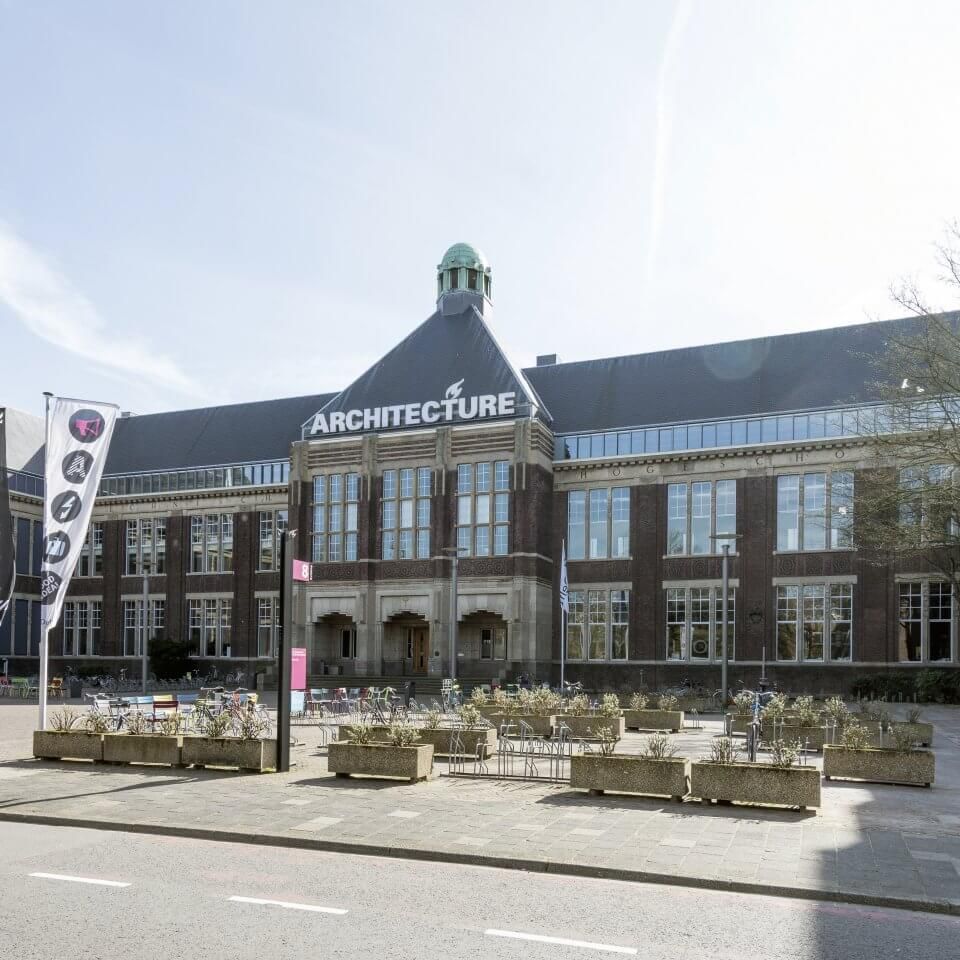
Rode Scheikunde - Walkingroute TU Noord
Today: Architecture and the Built Environment (BK City) Address: Julianalaan 134 Year of construction: 1918-1923 Architect: G. van Drecht
Former main building
The current Architecture and the Built Environment (BK City) premises on Julianalaan used to serve as the main building for the Delft University of Technology. This building - also known as ‘Rode Scheikunde’ (literally ‘Red Chemistry’) - together with the former buildings for Electrical Engineering, Physics and Geodesy was one of the first signs of the relocation of TU Delft south-eastwards from the centre of Delft to the Wippolder district.
At the time, this building was located furthest from the city centre, still completely surrounded by meadows. Originally, there was no intention to make this the main building of TU Delft and nor was it the first main building of the University. From the time of the foundation of the Royal Academy in 1842, the building at Oude Delft 95 had served as this function.
Red brick and original purpose
T…
Former main building
The current Architecture and the Built Environment (BK City) premises on Julianalaan used to serve as the main building for the Delft University of Technology. This building - also known as ‘Rode Scheikunde’ (literally ‘Red Chemistry’) - together with the former buildings for Electrical Engineering, Physics and Geodesy was one of the first signs of the relocation of TU Delft south-eastwards from the centre of Delft to the Wippolder district.
At the time, this building was located furthest from the city centre, still completely surrounded by meadows. Originally, there was no intention to make this the main building of TU Delft and nor was it the first main building of the University. From the time of the foundation of the Royal Academy in 1842, the building at Oude Delft 95 had served as this function.
Red brick and original purpose
The building owes the name ‘Rode Scheikunde’ to the colour of the bricks used and, of course, its original purpose. The Rode Scheikunde building is constructed in red brick, in combination with many natural stone elements. This stone can be found above and below the windows, in the continuous ridge beam and in the entire entrance section. Ornamental features are widely used, not only those in stone such as at the entrance but also figures sculpted in brick on masonry sections. At the time, fairly exclusive materials were used for the construction of the Rode Scheikunde building.
Water reservoir in the tower
The original purpose of the building can still be seen in a few places. For example, there are richly decorated bricked-up openings in the façade that may have served as fume cupboard outlets for chemistry experiments. There was a water reservoir in the tower that could be used in the event of a fire caused by such experiments.
Vibrating reagent racks
The decision to build the former Rode Scheikunde building was prompted by the very poor housing of the Department of Chemical Technology. This Department was located in a few buildings on Westvest. Numerous internal renovations weakened the building at Westvest to such an extent that merely walking through the premises caused various objects such as the bottles in the reagent racks to start vibrating. In the early months of 1917, it was decided that something needed to be done. Not only because of the poor condition of the premises, but also because of the great interest in this field of study. In order to accommodate everyone properly, a new building for Chemical Technology was considered necessary. At the time, the Analytical Chemistry Laboratory (part of the First Year Chemistry building at De Vries van Heijstplantsoen 2) was under construction at Wippolder. Partly because of the existing construction activities, the overlying grounds seemed ideal for the Department of Chemical Technology. Consequently, in June 1917, this site was purchased from the municipality so that the construction of new laboratories could be started. As long as the new laboratories were not yet ready for use, all efforts were made to offer chemistry students a place in the existing chemistry laboratories.
Economic slump
In the early 1920s, the government was confronted by an economic crisis. Exorbitant expenditures had to be avoided. There were scarcely any funds available even for essential activities. At the same time, future prospects for chemistry graduates were no longer as favourable as before; there was a much lower demand for chemical engineers than expected, while the number of graduates was steadily increasing. In the meantime, the new building was already under construction. The pace of construction slowed down and finally came to a complete standstill in mid-1923. The economic slump continued and cutbacks had to be made. For example, the government decided not to complete the new chemistry laboratories in Delft for the time being. The building carcass was ready and the walls and roofing were finished but the building was not yet watertight and airtight. Also, the pipes had not yet been laid and floors and ceilings were not yet finished. The official reason given for discontinuing construction was that the number of new students was below expectations.
The entire structure was fenced off. Anything that was not anchored to the building was removed or became severely damaged. Old construction timber was regularly used as firewood. Partly due to the continuation of the economic crisis, the plans to complete the new chemistry laboratories seemed to increasingly go up in smoke.
Suitable and modern premises after about 30 years
In December 1946, the move to the Gele Scheikunde building at Julianalaan 136 was completed: after being housed in extremely primitive conditions for about 30 years, the Department of Chemical Technology was finally relocated to more suitable and modern premises. The Rode Scheikunde building was eventually completed in the early fifties.